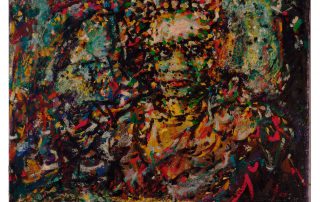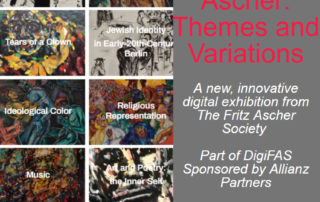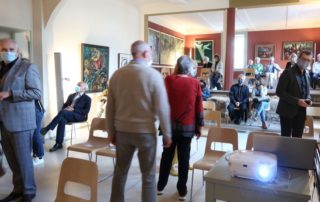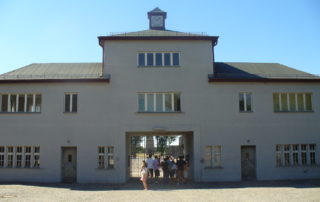Rachel Stern2022-02-18T07:19:09-05:00January 11th, 2021|Events, Lectures, Past Events|
WATCH THE RECORDING OF THIS EVENT HERE. Visual art during and after the Holocaust, by victims and survivors eloquently contradicts the famous comment by Theodor Adorno that "after the Holocaust to make art is barbaric." On the contrary, it was and is necessary: as part of the record of events as they were transpiring, and as part of the human response to horror--to express anger, to raise questions, to offer healing--in the time after those events. Who creates the art and what kind of art is created? What role does it play in wrestling with the question of what God is and what we humans are? These issues have implications both from within the heart of the Holocaust and from well beyond its particular boundaries. [...]
Elizabeth Berkowitz2024-03-05T08:12:14-05:00November 18th, 2020|Exhibitions|
This digital exhibition includes important examples from the oeuvre of the German Jewish Expressionist artist Fritz Ascher (1893-1970). Ascher’s career extended from prior to the First World War until the late 1960s. However, Ascher’s artistic trajectory was interrupted due to persecution under National Socialism, and he spent much of the Second World War in hiding, concealed in a family friend’s basement. Ascher’s work consequently encompasses both the vibrant artistic scene in early-20th-century Germany, as well as the trauma and aesthetic shifts consequent of Ascher’s persecution and deprivations during the twelve years of the Nazi regime. These selected works are representative not only of critical moments in Ascher’s personal and artistic development, but also of key themes that occupied Ascher’s [...]
Rachel Stern2020-11-24T20:14:35-05:00October 14th, 2020|Newsletter|
Dear Friends, On October 17 we celebrate Fritz Ascher’s birthday - this year with the launch of DigiFAS - diverse, innovative digital initiatives that provide new ways of engagement with the art and life of artists persecuted by an authoritarian regime. DigiFAS is generously sponsored by Allianz Partners. This launch includes the Society’s first-ever fully digital exhibition “Fritz Ascher: Themes and Variations.” You can explore the exhibition HERE. We have worked on this for months and can’t wait for your reactions! We also invite you to participate in the 2- week digital engagement project “Send in the Clowns,” which explores the clown as a figure between tragedy and comedy, between self- identification [...]
Rachel Stern2020-09-17T22:58:37-04:00September 17th, 2020|Newsletter|
Forum Jacob Pins in Höxter, Germany Dear Friends, The Jewish New Year is upon us, and it feels as if the New keeps coming. The exhibition “The Loner. Clowns in Fritz Ascher's Art (1893-1970)” at Forum Jacob Pins in Höxter, Germany was opened with an event following social distancing rules, my video greeting and a concert in the courtyard. The exhibition is on view until November 29, and I very much encourage you to see it (more information HERE). In the exhibition, Ascher’s depictions of clowns are contrasted with depictions of nature, which dominated his post-Holocaust work. Inspired by the nearby Grunewald, the artist created vivid landscapes and powerful close-ups of the sun, trees and flowers, which [...]
Rachel Stern2020-08-20T21:32:19-04:00August 20th, 2020|Newsletter|
Dear Friends, What a strange summer this is. But I have exciting news of some degree of normalcy: an exhibition in Germany! This is no small feast in these times, and I am thankful to my co-curator Julia Diekmann for her flexibility and creativity in co-organizing the exhibition. Who would have thought that the largest hurdle is getting the artwork out of the locked down campus of Richmond University? In the end it all worked - our shipper Cadogan Tate had just taken up operation again and flight schedules for art opened up, the drawings, which have never been shown before will be matted and framed practically overnight, the artwork will be hanged as fast as it probably never [...]
Rachel Stern2020-07-15T15:54:15-04:00July 9th, 2020|Newsletter|
Dear Friends, Antisemitism and racism are not the same. But they are both based on the lack of regard to the values this country was founded on: freedom, justice and equality. As a proud immigrant, I deeply believe in these values, admire the dynamic energy of this country, and hope that this unprecedented time helps speed up the process towards realizing these ideals of freedom, justice and equality for all. As an individual and as the executive director of the Fritz Ascher Society, I strive to do my part in this process. The Fritz Ascher Society tells the stories of artists, who lived and worked in Germany, as the country abandoned its first and very fragile democracy and instead [...]
Rachel Stern2020-03-03T09:05:47-05:00February 18th, 2019|Exhibitions, Past Exhibitions|
“In the Country of Numbers. Where the Men have no Names” tells the story of the detention and exile of November pogrom prisoners in the Sachsenhausen concentration camp on the basis of twelve individual destinies. One of those individuals is Fritz Ascher. The interviews presented in the exhibition with children and grandchildren of the persecuted as well as family biographical photos and documents are new material first shown in Germany, which was researched in the USA, Great Britain and Israel. More than 6,300 Jewish men were brought to the Sachsenhausen concentration camp after the November pogroms in 1938. After a few weeks, the vast majority was set free, with the condition to emigrate immediately from Germany. Many have therefore [...]









